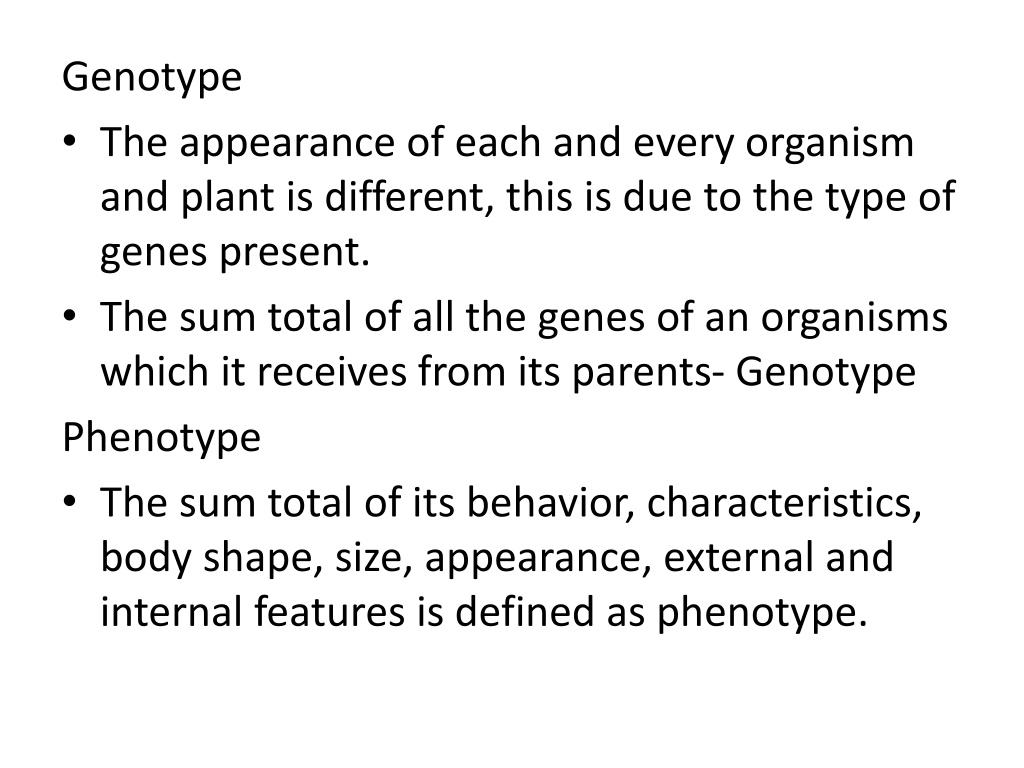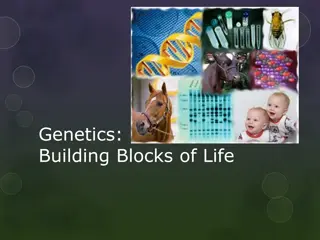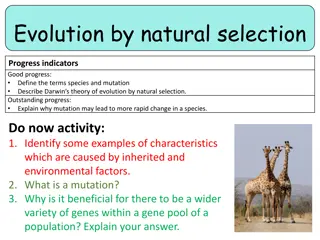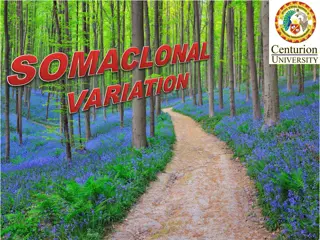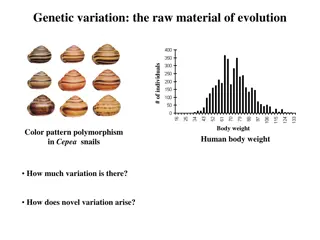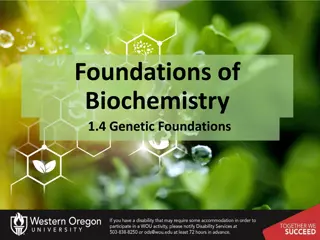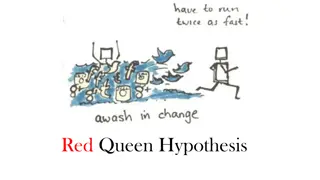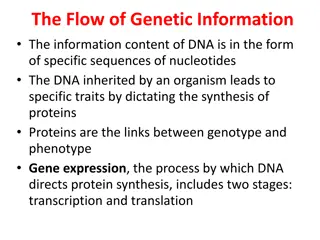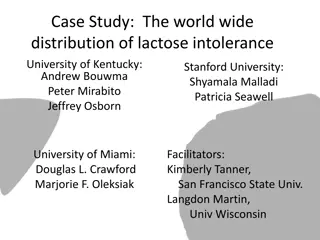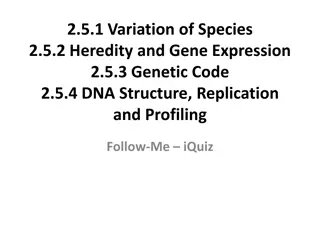Understanding Genotype and Phenotype: The Genetic Basis of Organism Variation
Genotype determines the genetic makeup of an organism, while phenotype encompasses its observable traits. Johannsen's theory states that phenotype is a result of genotype, which remains constant throughout life. The concept of phenocopy refers to mimicking another phenotype without altering the genotype. The norm of reaction illustrates how similar genotypes can produce different phenotypes in varying environmental conditions. Environmental factors play a crucial role in shaping an organism's phenotype. Human twins, whether identical or fraternal, provide insights into genetic inheritance and variation.
Download Presentation

Please find below an Image/Link to download the presentation.
The content on the website is provided AS IS for your information and personal use only. It may not be sold, licensed, or shared on other websites without obtaining consent from the author. Download presentation by click this link. If you encounter any issues during the download, it is possible that the publisher has removed the file from their server.
E N D
Presentation Transcript
Genotype The appearance of each and every organism and plant is different, this is due to the type of genes present. The sum total of all the genes of an organisms which it receives from its parents- Genotype Phenotype The sum total of its behavior, characteristics, body shape, size, appearance, external and internal features is defined as phenotype.
According to Johannsen the Phenotype of an individual is due to genotype but not vice versa Genotype is always constant. All characters-due to genotype Genotype is unchanged through out life except certain conditions. Phenotype keeps on changing due to growth ageing environment, nutrition and other abiotic factors.
Phenocopy-refers to replica of original or another phenotype. ex: a person immitates another person in appearance is known as phenocopy of natural phenotype. a person bleaches hair will only be able to change his appearance or phenotype but the genotype cant be changed. When dye fades natural hair color will be visible Morgan experiment in 1910 on drosophila flies.
Norm of reaction / Range of reaction Similar genotype interact with different environmental condition to produce different phenotype. Ex: in Himalayan rabbit which is white in color with black extremities, black tail, feet and ears with pink eyes. It is true breeding Varity. when white fur is removed from the region of back and area is exposed to cold temperature- black fur grows instead of white fur. When black fur is removed and the area is exposed to warm temperature or artificially kept warm by covering with bandage white fur grows instead of black fur
Location Environment Phenotype Days to start flowering Sea level on California coast Mild winter Plant has long stem long leaves Takes 200 days to start flowering 4,500 ft above sea level Warm summer and cold winter Plant more tall and slender Takes 50 to 60 days for start flowering 10,000 ft above sea level Winter- severe cold and long summer- short Plant- dwarf Taken 55 days to start flowering
Human twins Usually or normally human beings give birth to single child. But twin birth or multiple birth also occurs. Twins can be same or different sex. They are identical or dissimilar. Identical or monozygotic twins: always same sex and similar in appearance which derived from single zygote. Zygote- cleavage- 2 cell- separate- 2embrioes Fraternal or dizygotic twins: different sex- not identical- derived from 2 different zygote. Multiple birth due to more number ova(super ovulation)
Interaction of genes Inheritance of comb shape in poultry. The comb pattern in poultry is an identification feature. Different breeds of poultry have different comb pattern. The inheritance of comb structure was studied by Batson & Punnett. The leg horn breed has a single type of comb. Brahma breed has Pea comb. The Wyandotte breed has rose type of comb. All these are true breeding varieties. When they crossed rose comb Wyandotte with leg horn having single type of comb. The f1 generation consisted of birds with rose comb. Thus, it was proved that rose type of comb was dominant over single comb.
When they crossed a pea comb variety or the Brahmas with a leghorn having single type of comb. The F1 generation consists of birds with Pea comb was dominant over single comb. When two single comb or leghorn were crossed the F1 generation consists of birds having single type of comb. This was pure line. When they crossed rose comb variety or Wyandottes with Brahmas having Pea comb. The F1 gen comberation consists of birds with different type of, which they called Walnuts.
In the next experiment when they crossed two walnuts. The cross is typical monohybrid involved only one pair of contrasting characters but yielded a dihybrid cross results in F2 generation. The F2 generation is consisted of 4 types of birds. They are Walnuts, Rose comb, Pea comb & Single comb in the ratio of 1:1:1:1. Initially the result was puzzling, but bateson & punnett analyzed that more than one pair of genes controlled the comb pattern.
Two pair of genes were responsible for comb pattern. The rose comb pattern was due to dominant genes RR . The Pea comb pattern was due to dominant genes PP . The recessive form of two dominant genes rr & pp produced a single comb. The walnut pattern was due to the interaction or coming together of the genes R & P . The most important feature was that the birds with rose comb have dominant genes RR & recessive genes for pea comb pp .
Similarly birds with pea comb have the dominant genes PP & the recessive genes for rose comb rr . Example: A pure breed of rose comb variety (Wyandottes) was crossed with a pea comb variety (Brahmas). RR - rose PP - Pea comb R and P Walnut rr & pp Single comb
The F1 generation consists of Walnut. When the F1 generation birds were interbred the F2 generation consists of 4 types f birds Walnut, rose comb, pea comb & single comb in 1:1:1:1 ratio. Supplementary genes The comb shape in poultry is a result of interaction of two pairs of dominant genes. Each dominant gene is able to express itself when alone. The genes RR & PP when alone can produce rose comb or P comb respectively. But, when come together , they produce a new trait called Walnut. This is different from rose & pea comb.
The two pairs of genes RR & PP are called Supplementary genes as they supplement each other their production of Walnut. The supplementary genes can be defined as a pair of independent dominant genes which when together produced a new trait different from what each dominant gene in produced when alone.
